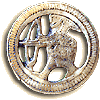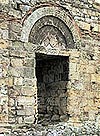![]() The Marcher Lords of England
The Marcher Lords of England


 When
dividing up the spoils of victory after 1066 William the Conqueror usually
gave a baron land in a number of different parts of the country to prevent
him developing a regional power base from which to threaten the crown. On
the Welsh border, however, William adopted a different policy.
When
dividing up the spoils of victory after 1066 William the Conqueror usually
gave a baron land in a number of different parts of the country to prevent
him developing a regional power base from which to threaten the crown. On
the Welsh border, however, William adopted a different policy.
Soon after the Conquest a rebellion by a Saxon thegn, Eadric the Wild, supported by Welsh allies, prompted William to create three powerful earldoms based on the towns of Chester, Shrewsbury and Hereford. The earls were given extensive judicial powers, almost becoming kings in their own domains, but in return they were expected to defend the frontier and extend Norman power into Wales. Typical of these so-called Marcher Lords (a march is a boundary or frontier area) was William FitzOsbern, Earl of Hereford, a powerful and ruthless warrior. By his death in 1071, he had pacified his part of the border and built a great castle at Chepstow on the Welsh side of the River Severn.
![Ludlow Castle, Shropshire [English Heritage]](1/ludcas1th.jpg)
 Within
the earldoms each lordship was centred on a castle and the densest concentration
of mottes and baileys in Britain was on the English - Welsh border. Alongside
many castles a borough, or small town, was established as a centre of administration
and economic activity. Good examples include Montgomery, close to a castle
established by Roger of Montgomery in former Welsh territory in 1070-4, and
Ludlow where the castle was begun by Roger de Lacy in 1085.
Within
the earldoms each lordship was centred on a castle and the densest concentration
of mottes and baileys in Britain was on the English - Welsh border. Alongside
many castles a borough, or small town, was established as a centre of administration
and economic activity. Good examples include Montgomery, close to a castle
established by Roger of Montgomery in former Welsh territory in 1070-4, and
Ludlow where the castle was begun by Roger de Lacy in 1085.
By the end of the 11th century William's policy, also followed by his son William Rufus, had paid off and the Marcher Lords had successfully extended Anglo-Norman power over much of Wales.